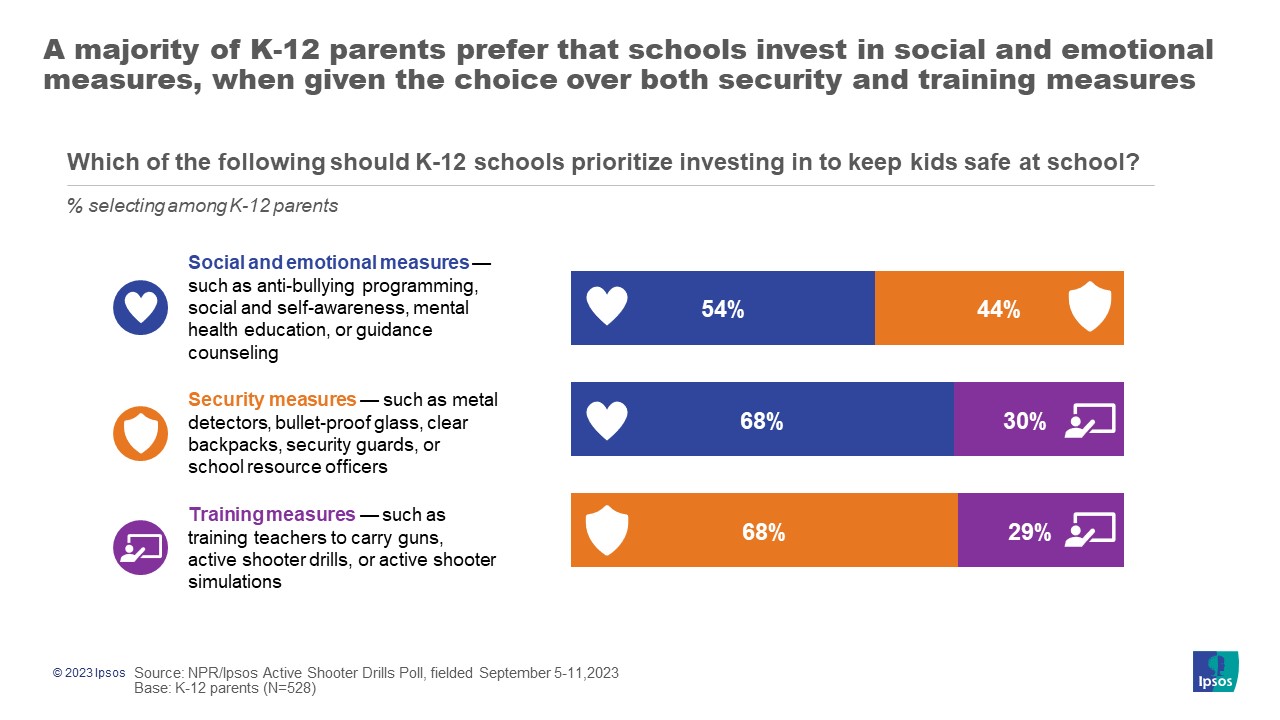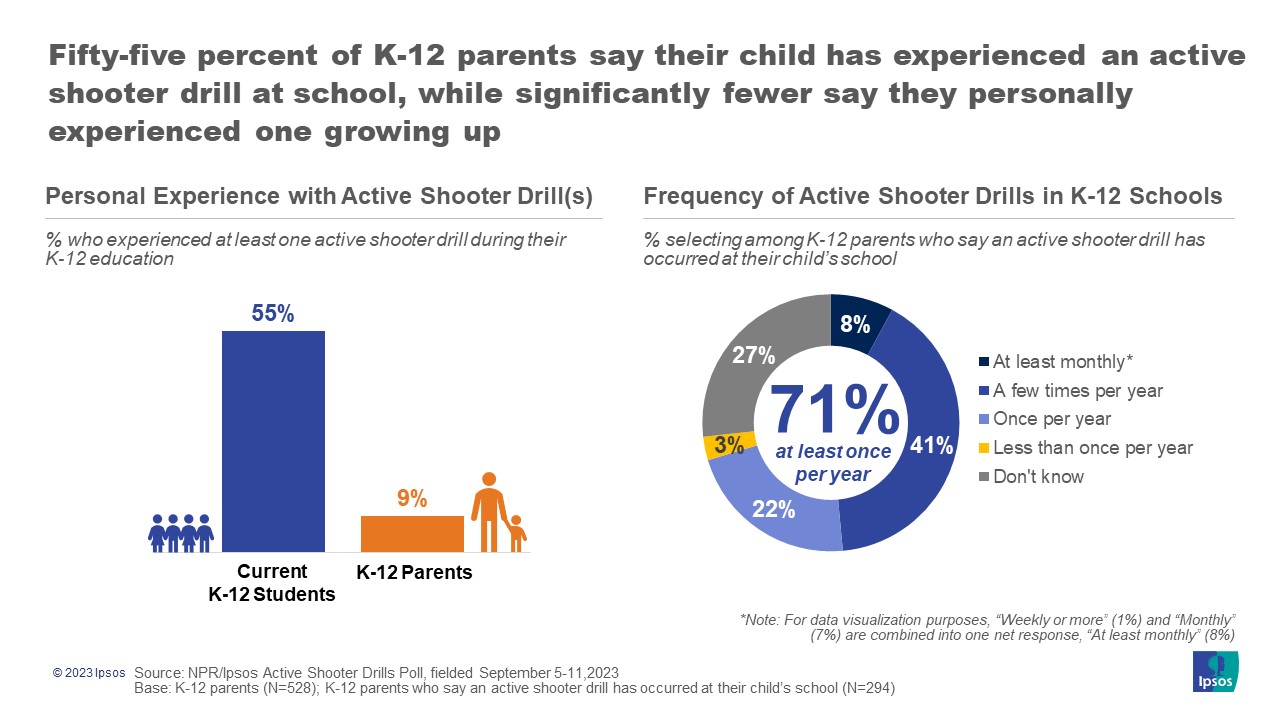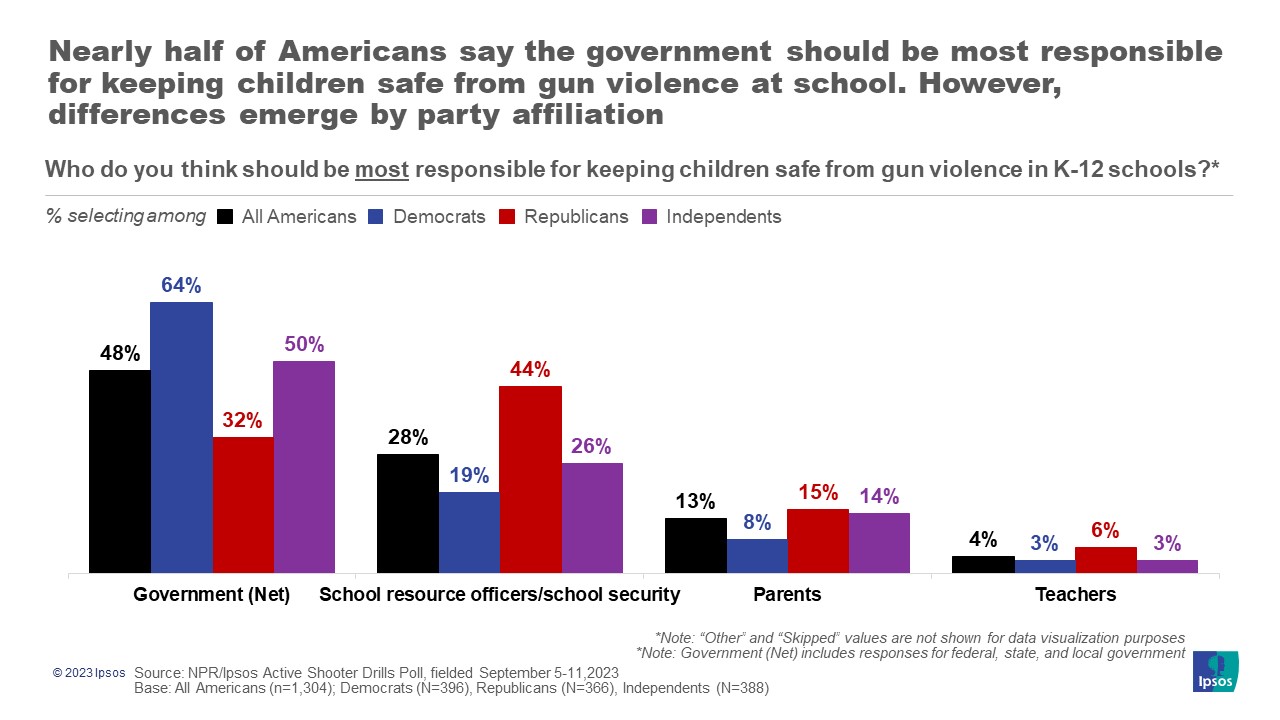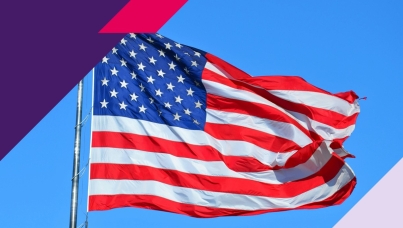Americans want active shooter drills in schools but differ on safety priorities
Washington, DC, October 24, 2023 – A new NPR/Ipsos poll of the American public and parents with a child in K-12 education finds that the vast majority of parents of school-aged children support their child having at least one active shooter drill per year at school, yet favor measures that are evidence-based and age-appropriate over more realistic scenarios. These types of drills are relatively common in schools, as more than half of K-12 parents report that an active shooter drill has occurred in their child’s school. When asked what K-12 schools should prioritize investing in to keep kids safe at school, a majority of parents and Americans alike say they prefer schools prioritize investing in social and emotional measures versus security measures or versus training measures. When asked who should be held most responsible for keeping children safe from gun violence at school, a plurality of K-12 parents, as well as a plurality of Americans as a whole, say the government—whether federal, state, or local—should be most responsible, followed by school security. However, differences emerge in these two questions based on one’s party affiliation.
For more information about this study, please click here.

Detailed Findings:
1. More than half of K-12 parents say their child has experienced an active shooter drill at school, while significantly fewer say they personally experienced one growing up. Despite the parent’s own experience (or lack thereof), most say children should experience an active shooter drill at least once per year.
- Nearly three in five K-12 parents (55%) say that an active shooter drill has occurred at their child’s school. Just 9% of K-12 parents say they themselves experienced an active shooter drill at any time during their K-12 education.
- The vast majority of K-12 parents (83%) say they are confident in their child’s school to keep them safe. However, the majority (53%) say they are somewhat confident, rather than very confident. Just 14% say they are not confident.
- Most K-12 parents (63%), regardless of party affiliation, agree that children should be required to participate in at least one active shooter drill per year, starting in kindergarten. Additionally, 80% agree that those drills should be evidence-based and age-appropriate.
- An overwhelming majority of K-12 parents support basic lockdown procedures (88%) and blocking doors with furniture (79%) occurring during an active shooter drill. A majority also supports warning students ahead of time (78%). Fewer support measures such as banging on the outside of classroom doors or using sounds of guns or gunshots (42% and 36%, respectively).

2. Although most Americans and K-12 parents support annual active shooter drills, they are divided when asked how America should prioritize reducing the number of school shootings. When asked how K-12 schools, in particular, should prioritize investments to keep kids safe at school, many prefer social and emotional interventions over training or security measures.
- About half of Americans (52%) say America should prioritize making schools safer to reduce the number of school shootings. In contrast, 45% say America should prioritize making guns harder to access. The broader public is evenly split: 48% want to prioritize making schools safer, and 49% err on the side of making guns harder to access. In both cases, there are significant party-line differences, as most Republicans favor making schools safer, while Democrats overwhelmingly want to prioritize making guns harder to access.
- When asked whether K-12 schools should prioritize investing in social and emotional measures versus training measures to keep kids safe at school, most Americans and K-12 parents say they prefer social and emotional measures over training measures (68% vs. 30%, respectively; percentages are the same for both audiences).
- Although most K-12 parents (54%) also prefer schools prioritize investing in social and emotional interventions over security measures (44%), the difference in preferred priorities is much smaller when comparing social and emotional measures to security measures than it is versus training measures. Again, the American public and parents are aligned on this preference.
- Similar to the question about what to prioritize to make schools safer, partisans are divided on how to do it. Most Democrats favor social and emotional measures (anti-bullying programming, mental health education, etc.), and the majority of Republicans want greater investment in security (metal detectors, clear backpacks, school resource officers, etc.).
3. A plurality of Americans says the government should be most responsible for keeping children safe from gun violence at school, followed by school resource officers or security.
- Nearly half of Americans (48%) say the government—whether federal (22%), state (14%), or local (12%)—should be most responsible for keeping children safe from gun violence in K-12 schools.
- Meanwhile, 28% of Americans say school resource officers or school security should be most responsible.
- Democrats and independents are more likely than Republicans to say the federal or state government should be most responsible for keeping children safe from gun violence in K-12 schools. On the other hand, Republicans are more likely to say that school resource officers or school security should be most responsible.
- Young Americans, ages 18-34, are more likely than older Americans—ages 35-49, 50-64, or 65+—to say the government should be most responsible for keeping children safe from gun violence (61% vs. 48%, 40%, and 45%, respectively).
- Americans who have experienced an active shooter drill are more likely to say the government should be most responsible versus those who have not experienced an active shooter drill (68% vs. 47%, respectively).

About the Study
These are the findings of an NPR/Ipsos poll conducted September 5-11, 2023, by Ipsos using our KnowledgePanel®. This poll is based on a representative probability sample of 1,304 adults aged 18 or older. This sample includes 528 parents who are adults ages 18+ who have K-12 school-aged child(ren).
The survey was conducted using KnowledgePanel, the largest and most well-established online probability-based panel that is representative of the adult US population. Our recruitment process employs a scientifically developed addressed-based sampling methodology using the latest Delivery Sequence File of the USPS – a database with full coverage of all delivery points in the US. Households invited to join the panel are randomly selected from all available households in the U.S. Persons in the sampled households are invited to join and participate in the panel. Those selected who do not already have internet access are provided a tablet and internet connection at no cost to the panel member. Those who join the panel and who are selected to participate in a survey are sent a unique password-protected log-in used to complete surveys online. As a result of our recruitment and sampling methodologies, samples from KnowledgePanel cover all households regardless of their phone or internet status and findings can be reported with a margin of sampling error and projected to the general population.
The study was conducted in English. The data were weighted to adjust for gender by age, race/ethnicity, education, Census region, metropolitan status, household income, and parental status. The demographic benchmarks came from the 2022 March Supplement of the Current Population Survey (CPS). Additionally, the indicator for parents of K-12 school-aged children was derived from the weighted main sample.
- Gender (Male, Female) by Age (18-29, 30-49, 50-64, 65+)
- Race-Ethnicity (White/Non-Hispanic, Black/Non-Hispanic, Other/Non-Hispanic, Hispanic, 2+ Races/Non-Hispanic)
- Education (Less than High School, High School, Some College, Bachelor or Higher)
- Census Region (Northeast, Midwest, South, and West)
- Metropolitan Status (Metro, Non-Metro)
- Household Income (Under $25K, $25K-$49,999, $50K-$74,999, $75K-$99,999, $100K-$149,999, $150K and Over)
- Parental Status (Parent of school age kids, Not parent of school age kids)
The margin of sampling error is plus or minus 3.2 percentage points at the 95% confidence level, for results based on the entire sample of adults. The margin of sampling error takes into account the design effect, which was 1.36. The margin of sampling error is higher and varies for results based on sub-samples. The margin of sampling error for parents of K-12 school-aged children is plus or minus 4.9 percentage points at the 95% confidence level, with a design effect of 1.33. The margin of sampling error is higher and varies for results based on sub-samples. In our reporting of the findings, percentage points are rounded off to the nearest whole number. As a result, percentages in a given table column may total slightly higher or lower than 100%. In questions that permit multiple responses, columns may total substantially more than 100%, depending on the number of different responses offered by each respondent.
This topline includes trended data from two previous NPR/Ipsos polls. The first poll was conducted from February 27-28, 2018, and it included a non-probability opt-in sample of 1,005 adults ages 18+. The second poll was conducted from June 10-12, 2022, and it included a representative probability sample of 1,028 adults ages 18+. In the February 2018 poll, the credibility interval is plus or minus 3.5 percentage points for all respondents. In the June 2022 poll, the margin of sampling error is plus or minus 3.3 percentage points at the 95% confidence level for all respondents. More information about the February 2018 poll can be found here. More information about the June 2022 poll can be found here.
For more information on this news release, please contact:
Mallory Newall
Vice President, US
Public Affairs
+1 202 374-2613
About Ipsos
Ipsos is the world’s third largest market research company, present in 90 markets and employing more than 18,000 people.
Our passionately curious research professionals, analysts and scientists have built unique multi-specialist capabilities that provide true understanding and powerful insights into the actions, opinions and motivations of citizens, consumers, patients, customers or employees. We serve more than 5000 clients across the world with 75 business solutions.
Founded in France in 1975, Ipsos is listed on the Euronext Paris since July 1st, 1999. The company is part of the SBF 120 and the Mid-60 index and is eligible for the Deferred Settlement Service (SRD).
ISIN code FR0000073298, Reuters ISOS.PA, Bloomberg IPS:FP www.ipsos.com



